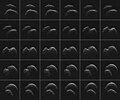|
(671294) 2014 JO25
(671294) 2014 JO25 is a near-Earth asteroid. It was discovered in May 2014 by astronomers at the Catalina Sky Survey near Tucson, Arizona - a project of NASA's NEO (Near Earth Object) Observations Program in collaboration with the University of Arizona. Orbit and classification2014 JO25 belongs to the Apollo asteroids, which cross the orbit of Earth. Apollos are the largest group of near-Earth objects with nearly 10 thousand known members. It is also a potentially hazardous asteroid due to its sufficiently large size (an absolute magnitude brighter than 22), and its Earth-MOID (see below) of less than 0.05 AU. It orbits the Sun at a distance of 0.25–3.90 AU once every 3 years (1,086 days; semi-major axis of 2.07 AU). Its orbit has an eccentricity of 0.89 and an inclination of 25° with respect to the ecliptic.[1] This makes it also a Venus- and Mercury-crossing asteroid. The body's observation arc begins with a precovery taken by Pan-STARRS in May 2011, or 3 years prior to its official first observation at Mount Lemmon.[2] Close approachesThis asteroid has a minimum orbital intersection distance (MOID) with Earth of 1,650,000 km; 1,020,000 mi (0.0110 AU), which translates into 4.3 lunar distances.[1] 2017 Earth flyby2014 JO25 made a close flyby of Earth on 19 April 2017, and at its closest approach on that date came within 1.8 million kilometers (1.1 million miles) of the planet. It reached an apparent magnitude of 10.76. The 2017-flyby within a distance of 1.8 million kilometers was the closest approach to Earth by 2014 JO25 for at least the next 400 years.[5] History of close approaches of large near-Earth objects since 1908 (A)
Physical characteristics2014 JO25 is a peanut-shaped contact binary asteroid. It is an assumed to be a stony S-type asteroid.[4] The overall shape of the asteroid also resembles the “rubber ducky shaped” nucleus of Comet 67P/Churyumov-Gerasimenko.[6][7] Diameter and albedoEarly estimation based on observed absolute magnitude and estimated albedo indicates object 600–1400 meters (m) in diameter. In 2014, further research based on NEOWISE data indicated an object of 650 m in diameter and albedo 0.25.[8] Based on a generic magnitude-to-diameter conversion, 2014 JO25 measures approximately 720 m in diameter, using an absolute magnitude of 18.1 and assuming an albedo of 0.20, which is typical for stony asteroids.[3] The Collaborative Asteroid Lightcurve Link assumes an albedo of 0.20 and calculates a diameter of 818 meters based on an absolute magnitude of 17.8.[4] Observation of the asteroid with the Goldstone Solar System Radar were performed between April 15 and 21, 2017 by Arecibo Observatory and Goldstone Solar System Radar. Results show that the largest dimension of this contact binary is at least 870 meters.[4][9] Rotation periodThe 2017 radiometric observations at Arecibo and Goldstone also gave a rotation period of approximately 4.5 hours.[9] Also in April 2017, a rotational lightcurve of this asteroid was obtained from photometric observations by Brian Warner at the Palmer Divide Station (U82) in California. Lightcurve analysis gave a refined period of 4.531 hours with a brightness amplitude between 0.14 and 0.64 magnitude (U=n.a.).[10] Numbering and namingThis minor planet was numbered by the Minor Planet Center on 22 March 2024 (M.P.C. 172656).[11] As of April 2024[update], it has not been named.[2] GalleryRadar images of the asteroid were taken on 18 April 2017 by the Goldstone Solar System Radar:
In context2014 JO25 on a graph plotting the closest flyby distance to Earth and size of NEOs in 2017.  References
External linksWikimedia Commons has media related to 2014 JO25.
|
|||||||||||||||||||||||||||||||||||||||||||||||||||||||||||||||||||||||||||||||||||||||||||||||||||||||||||||||||||||||||||||||||||||||||||||||||||||||||||||||||||||||||||||||||||||||||||||||||||||||||||||||||||||||||||||||||||||||||||||||||||||||||||||||||||||||||||||||||||||||||||||||||||






